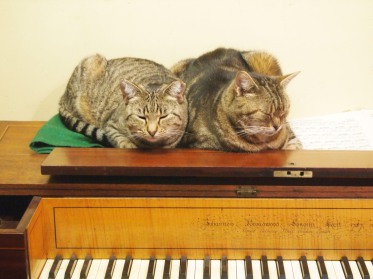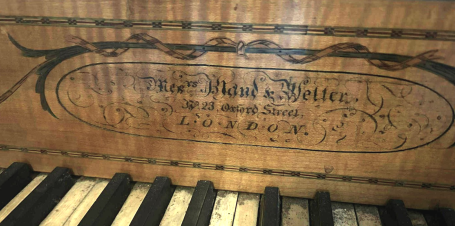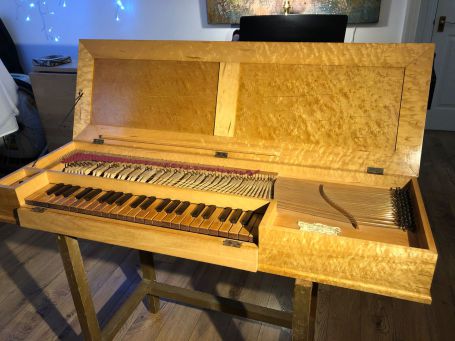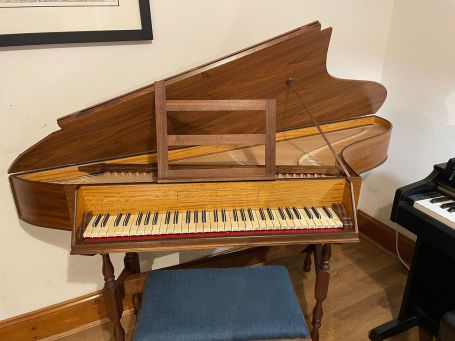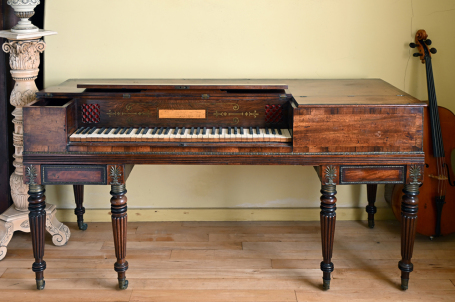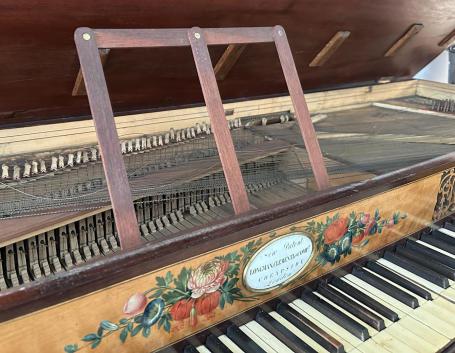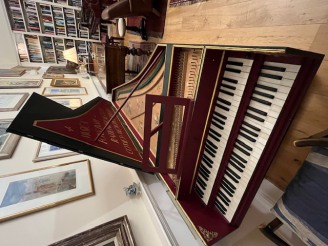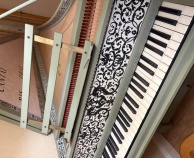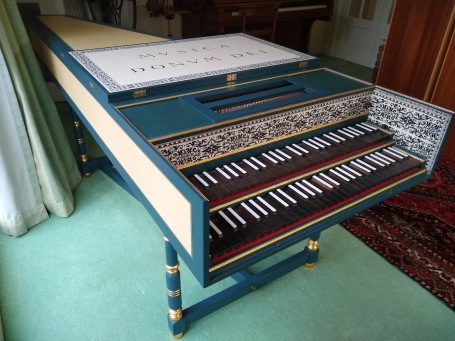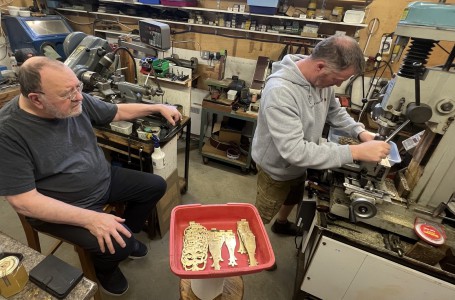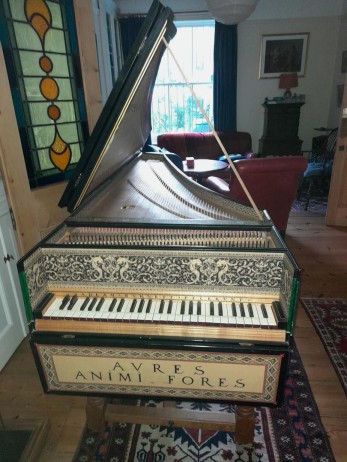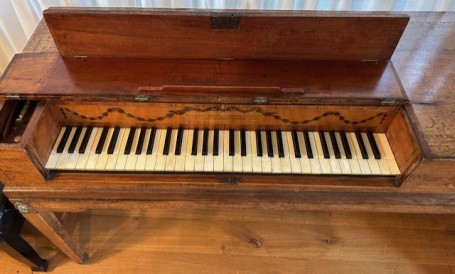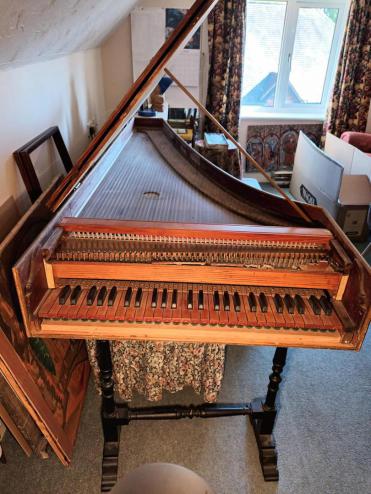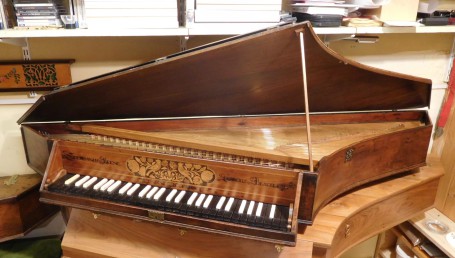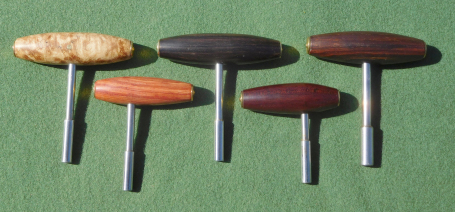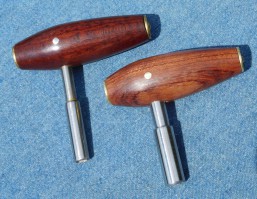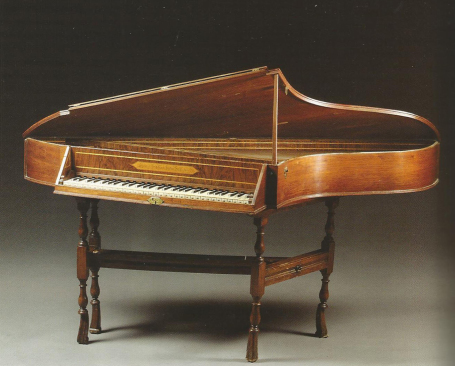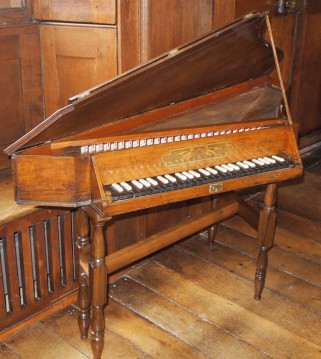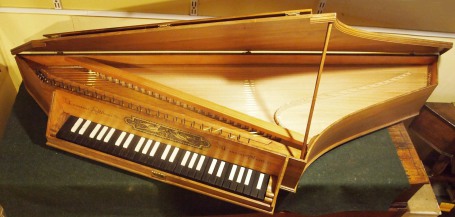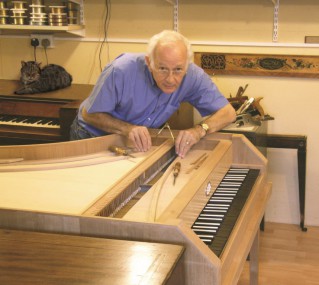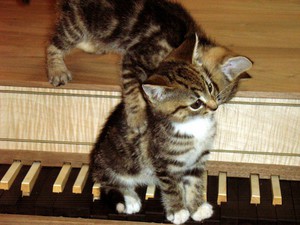
Welcome to
Friends of Square Pianos
This is a website for anyone who owns, or would like to own, a square piano, or possibly a spinet. Or a harpsichord, or a clavichord... Or anyone who is just interested, and would like to learn a little more.
Please get in touch with me, David, on friends.sp@btinternet.com with questions, comments, or just to say 'Hello'. This is a site for everyone, especially those new to the world of Early Keyboard Instruments. And of course, we very much appreciate the support of those with more experience.
Update January 16th
Bland & Weller - New Home Found
Clavichord by Paul Watson 1990 For Sale
Spinet after Thomas Hitchcock
by Stephen Robinson 2009 For Sale
Bland & Weller - New Home Found
Most of our piano makers were men, but this is an exception. Anne Bland founded a London music publishing and piano making business in 1784, and took in E Weller (possibly also a woman) as her partner in 1792. She retired in 1818; the business was located at 23 Oxford Street for the whole of this time. The five-octave compass and style of the nameboard decoration indicate a date of probably near to 1800. It is interesting to note that the nameboard inscription reads 'Mesrs Bland & Weller'. We are happy to say that it has quickly found a new home.
Pictures and details are still on the Sale Page.
Clavichord by Paul Watson 1990 For Sale
This beautiful triple fretted clavichord, made by Paul Watson of Stoke Newington (London) in 1990 is now offered for sale. A special feature is the beautiful birds' eye maple veneer. The compact size makes it an ideal travelling companion, and it has a considerable amount of sound for its size! We do not know the original instrument it was copied from, but it is similar to some South German clavichords. Double-strung in brass, compass C/E - c3 by short octave. It was restrung in Instrument Workshop brass in 2019, including six twined strings to enhance the bass on the recommendation of Peter Bavington.
Please see the Sale Page for full details
Spinet after Thomas Hitchcock
by Stephen Robinson 2009 For Sale
This beautiful spinet by Stephen Robinson is based on the c. 1728 Thomas Hitchcock spinet in the Russell Collection of Early Keyboard instruments in Edinburgh.
Please see the Sale Page for pictures and full details.
Broadwood 1815 For Sale
This handsome Broadwood is number 20015, indicating a date of 1815. It does need work, but appears to be structurally sound with remarkably little sign of any twist. As is so often the case, the pedal has been lost at some time in the past.
The entry from the Broadwood Porters' book reads:
"Thursday 9 March 1815
Hime
Three SPF Best with drawers nos. 19767, 19819, 20015 and cases addressed Mr M Hime, Dublin, mark3ed H, to the care of Mr Simmons, Liverpool, and delivered at Paddington to go by Pickfords boat, paid 6d
Kinsley [porter]"
Please see the Sale Page for pictures and details.
Longman, Clementi & Co c. 1799 Sold
This piano is from the period when the famous composer and pianist Muzio Clementi was in the process of rescuing the bankrupt firm of Longman & Broderip. It does need a full restoration, but it has the potential to be a very attractive piano. The nameboard and ivories are in excellent condition; the individually painted floral decoration is the most elaborate and beautiful of the designs, featuring Rosa centifolia, Turks' cap lilies, sweet peas, and morning glory.
Please see the Sale Page for pictures and details.
John Storrs Harpsichord 1980s For Sale
When skilfully built, as this one is, John Storrs kits make fine instruments. This one has a compass GG - e3, with 2x8' stops and 4', buff t0 8' and a shove coupler. It is tuned to A=440, and is also happy at 415. The natural keys are bone - no ivory worries! Please see the Sale Page for pictures and details.
Dolmetsch Small Spinet For Sale
In the last years of the nineteenth century, Arnold Dolmetsch was the original pioneer of the harpsichord revival in Great Britain. In the early years of the twentieth century he saw it as his mission to take the harpsichord to the people, and he specialised in designing and building compact instruments - notably small enough to be taken around in a London taxi. This tradition continued in the Dolmetsch workshops after his death, and this compact spinet, made c. 1965, is typical. Please see the Sale Page for details.
Robert Deegan 'Flemish' harpsichord 2002
This beautiful harpsichord by Robert Deegan was maintained by him until his recent retirement; it has since been cared for by Alex Temple, and is now offered in full playing order.
Please see the Sale Page for full details
Harpsichord by John Storrs 1984 Sold
I have great respect for John Storrs' kits. He employed techniques, very advanced for the time, to ensure that the hundreds of little holes were in the right place - this would now be called CNC machining. The technique also allowed special key-pieces to be inserted to secure the case joints. These factors gave careful amateurs the best possible chance of achieving a good result; this is a fine example of the Ruckers inspired model, made from a kit in 1984. Please see the Sale Page for pictures and full details.
I am particularly happy to say that an arrangement has been reached for this beautiful and practical instrument to support the endeavours of a young musician with a particular interest in the harpsichord. These young people are our future.
'David Law' Brassware - Progress Report
We are delighted to report that the plan for the continuity of David Law's beautiful brassware is going well, and now seems to be assured of success. Under the guidance of David, Tony Holland is now spending more time in the workshop, and setting up his own facility. In the picture below, we see some of the first production. A full progress report is in the attached document.
Microsoft Word document [14.7 KB]
Thanks to all who have contributed to enable this project, which will benefit us all. More funds are needed to help by machinery for the new workshop. Please contribute if you can, by following the link below.
https://www.justgiving.com/crowdfunding/keyboardsbrassfurniture
Adlam Burnett 'Flemish' Harpsichord c. 1975 Sold
This beautiful instrument is by my favourite modern maker and good friend, Derek Adlam. Based on the single-manual instruments of the Ruckers dynasty, it was made during the early years of the Finchcocks workshops. The original instruments had a compass of just four octaves C/E - c3 short octave, with one 8' and one 4' stop. Much respected for their fine tone, in the eighteenth century nearly all were extended by a process of 'ravalement' in either France or England. The Derek Adlam scheme is unusual in having a broken octave keyboard using the apparent BB key to play GG, and retaining the low sharps with the divided C# playing AA on the front portion and C# at the back. D# plays BB and D#. The top note is d3. Thus the keyboard layout is that used by Stephen Keene and others for English spinets c. 1690 - 1710. It also has an additional set of 8' strings. It has bone keys, and the original plastic jacks were replaced with wooden sets in new registers in 2023, with goose-quill plectra. It has recently been re-strung with Burkett historic brass and P-iron. It was built for A 44o and is non-transposable due to the broken octave, but it would surely be happy at A415. Please see the Sale Page for pictures and details.
George Garcka c. 1785 Sold
George Garcka built pianos in Stephen Street, Rathbone Place from 1783 to 1792 before moving to the famous address on the 'Corner of Edward Street and Wardour Street'. This attractive piano, in full working order, has now been sold. Please see the Sale Page for pictures and details.
Zuckermann 'Italian' Harpsichord - Sold
This Zuckermann harpsichord dates from the 1970s, when it was a popular and practical kit instrument. This example was built some time ago, but has lain fallow for a number of years. It does now need some work, but will be an ideal first project. Please see the Sale Page for pictures and details.
Two Beautiful Original English Spinets
at Woolley & Wallis (Salisbury) on 2nd July
It is rare to see an original eighteenth-century English spinet at auction - something very special when two turn up at once. And with no reserves!
Please see the special Two Beautiful Spinets page for pictures and full details.
Tuning Hammers for 'Zither Pins'
For some reason it seems to be difficult to obtain tuning hammers with small square sockets to fit many modern instruments such as Morley spinets and clavichords and many harpsichords. However, I have been able to obtain a number of suitable sockets, which I can make up into tuning hammers. For technical reasons these have brass stems with steel inserts. The image shows a standard 5 mm diameter 'zither pin' with a head measuring 4 mm square at the top. Please see the 'Tuning and Tuning Hammers' page for more details.
The History of the unique 3¼-octave piano from the original Broadwood Archives
Update - More about the Crawley Family
Thanks to diligent research by Robert Simonson, we now have the full history of this unique piano, to be sold in the Gardiner Houlgate sale on 14th March. Please click HERE for the full story.
© The Surrey History Centre
Harpsichord Music from the time of Louis XIV
Played by Sophie Yates
I am happy to recommend this recording by Sophie Yates, played on a harpsichord by Andrew Garlick after the Vaudry instrument in the V&A collection . Delightful music, beautifully played. Some lesser-known pieces, perhaps my favourites are those by Louis Couperin.
For the link to order, please click HERE
Kirckman Harpsichord 1786 - Sold
This magnificent instrument by Jacob and Abraham Kirkman is an example of the fully-developed English harpsichord, with the keyboard including the low FF#, an integrated music-desk, a nag's head swell, and a machine stop. Please see the Sale Page for pictures and full details, including an explanation of the machine stop!
Plans for Keene & Brackley Spinet -
Now Affordable!
The famous Keene and Brackley spinet is rightly the model for many reproductions, both amateur and professional. I am happy to announce that by courtesy of the copyright owner of John Barnes' original plan, we are now able to offer copies at an affordable price; they are now available through Friends of Square Pianos for just £20, plus carriage at cost. Please note that this is the original plan taken from the original instrument in the picture, not the EMS kit version which had two added sharps for GG# and d3#.
Even if you are not going to build an instrument yourself, anyone with an interest in spinets will find this plan fascinating.
Please see the new page Plans For Sale for details of plans of spinets, harpsichords, and clavichords offered at reasonable prices.
Bespoke Tuning Hammers
Early keyboard Instruments, whether originals or replicas, do require more frequent tuning than modern iron-framed pianos. The costs of professional tunings mount up, and it can also be a problem finding a tuner who is happy to work with our ancient instruments. For this and other reasons, most of us do our own tuning. To offer some help to those thinking of having a go, I have prepared a short PDF guide, available on request.
It is very important to have a properly-fitting tuning hammer, which should bear on a good portion of the two flat faces of the wrestpin (tuning-pin). If the fit is too sloppy, the corners of the pin and the socket of the tuning hammer will be damaged, and the backlash makes accurate tuning difficult anyway. If it is too small, it will grip the top of the pin only, with the same result.
I am able to offer a limited number of hand-made hammers tailored to your own pins, either directly or via a template. Please see the Tuning and Tuning Hammers page for details. Sadly, in view of the EU General Product Safety Regulation, effective from 13 December 2024, I am no longer permitted to supply these to EU countries or Northern Ireland.
I have made a number of very short and lopsided hammers; these have proved popular with owners of Broadwoods and other pianos with the pins at the back, and also with spinet owners. In both cases the lid makes tuning difficult (unless it can be thrown right back) and these special hammers can help. They don’t look as elegant as the long-stemmed symmetrical type, but they are quite practical!
The Spinets of the Hitchcock Dynasy - Names, Numbers, and Dates
The second of these two essays builds on the first ('1664 and All That' - see below) and offers a new interpretation of the data concerning the establishment of Thomas Hitchcock as the leading spinet maker. It explains the somewhat confusing numbering sequences, their relationship to dates of manufacture, and the change on the nameboard from Thomas to John. As before, the piece is rather long to transfer directly to this page, so please open the PDF below.
Adobe Acrobat document [1.2 MB]
1664 and All That
Some confusion still surrounds the early life and career of Thomas Hitchcock. When was he active? Who was ‘Thomas Hitchcock the Elder’? One of the first histories of keyboard instruments in Britain was written by Edward Rimbault (pub. 1860). He tells us that “John [!] Hitchcock made these little instruments of a compass of five octaves. Several specimens still exist bearing dates between 1620 and 1640” It is likely that Rimbault mistook front numbers for dates, and numbers as high as this would indeed have carried the name of John Hitchcock, but it seems surprising that he had apparently never seen Hitchcock spinets carrying numbers which could not possibly have been dates, such as 1460.
Perhaps the most important early historian for keyboard instruments was Alfred Hipkins of Broadwoods. He compiled the catalogue for the 1885 International Inventions Exhibition, and used this experience for his 1888 book ‘Musical Instruments – Historic, Rare, and Unique’. It is in this book that Hipkins makes the notorious statement “…Thomas Hitchcock, whose autograph appears in spinets from 1664 and 1703.”
His famous 1896 book ‘A Description and History of the Pianoforte’ repeats this as “Thomas Hitchcock’s written dates found within instruments made by him cover the long period between 1664 and 1703.” But he then goes on to note that Hitchcock was the first to number his instruments, so he did realise that the numbers on the nameboards were not dates.
As so often happens, later authors followed these statements as unchallenged facts, and the misunderstanding is repeated in James (1933) and Russell (1959). Boalch ‘Makers of the Harpsichord and Clavichord’ (2nd edition 1974 and presumably 1st edition 1956) has a variation of the muddle, ascribing ‘1664’ to ‘Thomas the Elder’, and ‘1703’ to ‘Thomas the Younger’. Even the 3rd edition (1995) still has the entries, but the editor (Charles Mould) does realise that something is not quite right, and offers the plaintive statement: “…1664 does seem early for a wing spinet in London, and the date may have been misread. If it were possible to locate this, and the other early Hitchcock instruments, it would be possible to be more precise about the identity and dates of the members of the Hitchcock family in the early years of their workshops.”
So it was that, having kept a low profile since 1885, the mysterious ‘1664 Hitchcock’ emerged from the shadows. This is the story of an important little spinet – it is my privilege to be part of the story.
The essay is a bit long to transfer to this page directly, so please open the PDF below. All comments welcome!
Adobe Acrobat document [942.5 KB]
Making a Spinet
Some of you may have followed the construction - starting from a pile of wood - of this replica of a remarkable and important instrument. The spinet is now complete and playing well, and has gone to its new home in the Sigal Music Museum in South Carolina. Please see the Spinet Page for the story.
About the 'Webmaster' (David Hackett)
My only claim to respectability is that Carl Dolmetsch once offered to take me on as an apprentice. This was in 1962, when I had just shown him my first clavichord, and been his guest at Haslemere. However, he also advised me that it would be better to go to University, and I accepted his advice. Early Keyboard Instruments have therefore remained a hobby, and now happily retired, I am able to spend a bit more time enjoying them - and encouraging others, I hope..
